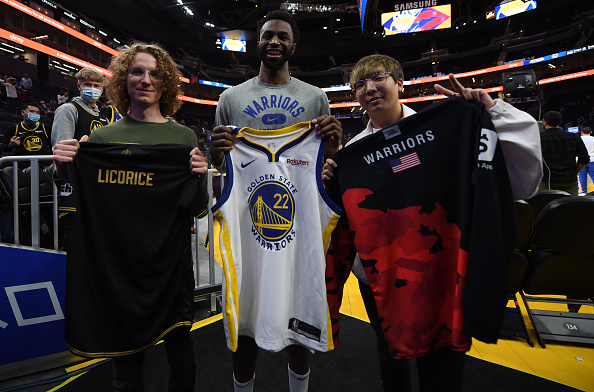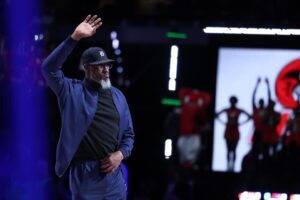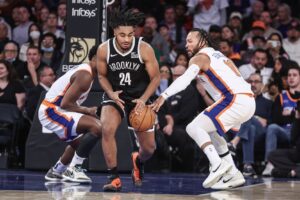The Golden State Warriors’ NBA Finals win provides the perfect opportunity to revisit the path that got the team to the title. No trades were more important to the formation of this group than the series of moves that turned Kevin Durant into Andrew Wiggins and Jonathan Kuminga. Of course, the Warriors’ trade wasn’t so simple.
D’Angelo Russell signed a max contract with the Nets after being named an All-Star as an injury replacement before being traded to the Warriors. Russell moved to chilly Minnesota after a cameo as a Warrior to fulfill former Timberwolves GM Gersson Rosas’ dream. Who won the trade between Minnesota and Golden State?
Grading the Golden State Warriors’ Trade for Andrew Wiggins
The History
The Warriors lost the 2019 NBA Finals in part due to Durant’s Achilles tear. He was determined to leave Golden State. GM Bob Myers worked quickly to ensure the Warriors got something in exchange for Durant’s departure and negotiated a sign-and-trade with the Brooklyn Nets to receive Russell.
Russell had been discussing a contract with Rosas and the Wolves when Myers executed the trade. Golden State had to send Andre Iguodala and a lightly-protected 2024 first-round pick to Memphis in order to receive Russell in a sign-and-trade, an indication of their zeal for the deal. Stephen Curry broke his hand five games into the 2019-2020 season, and the team never recovered. Russell was traded to Minnesota just before the 2020 deadline with the Warriors’ record at 12-40.
Terms of the Deal
The Warriors received: Wiggins, Minnesota’s 2021 first-round pick (top-three protected; the Warriors selected Kuminga with the seventh pick)
The Timberwolves received: Russell, Jacob Evans, Omari Spellman
The Golden State Warriors’ Trade Grade: A
The Warriors’ title win secures an “A” for the Warriors. It also serves as a reminder of how long it can take to evaluate a trade fully. The Wolves needed to include their lightly-protected first-round pick because of Wiggins’ low reputation league-wide.
Wiggins has transformed in Golden State. He performed well as the primary defender of wing scorers in 2020-21, and defended more point guards last season. He’s scoring just 1.7 fewer points per game in Golden State despite the increased talent around him. He’s shot 38% and 39.3% from three in his last two seasons after posting a high mark of 35.6% for Minnesota in 2016-17.
Wiggins’ improvement shows us the importance of a team’s situation in a young player’s development. He played for four coaches and five lead decision-makers in 6.5 Minnesota seasons, with surrounding expectations changing constantly. The Warriors’ stability has led to a clear role for Wiggins: defend the opponents’ best player, hit open threes, and score in the paint. Wiggins turned 25 just after joining the team in 2020. He’s shown improvement can occur in years seven and eight of a player’s career, not just in years one and two.
Kuminga represents a bridge to a bright post-dynasty future for the Warriors. The coaching staff trusted him to guard Ja Morant and DeMar DeRozan last season. He’s physically imposing and has flashed midrange shot creation that echoes Kawhi Leonard’s bullying attacks. The Warriors negotiated Minnesota’s pick protections well. Had the no. 7 pick not conveyed in 2021, they would have been stuck with Minnesota’s no. 19 selection in the 2022 draft. The inclusion of Evans and Spellman allowed the Warriors to avoid the luxury tax in the 2019-20 season and, later, the repeater tax.
The Minnesota Timberwolves’ Trade Grade: C-
The Minnesota Timberwolves end up with the lower grade in this exchange but didn’t “lose” the trade. The Timberwolves could never create a winning situation around Wiggins. It’s unclear if Wiggins would have blossomed in the same way had he stayed in Minnesota. Russell was also an integral piece of this year’s team which earned the franchise’s first postseason win since Minnesota made the Conference Finals in 2004.
This trade also placated Towns, who had been rumored to be unhappy with Minnesota before becoming Russell’s teammate. He just signed a supermax extension that keeps him in Minnesota through at least the 2026-27 season.
Russell’s main issue throughout his career has been lackadaisical defense. He has good size but struggles to move laterally, and needs to make improvements to survive in the playoffs. The addition of Rudy Gobert will help, but he can’t solve everything (just ask the Utah Jazz). Russell took just 3.7 free throw attempts per game last season and isn’t quite the shooter his reputation suggests (35.6% for his career). In sum, Russell is an inconsistent shooter and scorer, a playmaker who rarely gets in the paint, and a non-defender.
He has time to address these weaknesses at 26, but he’ll need to do so quickly with the Timberwolves trying to win now. The ascending Anthony Edwards will take more ball-handling duties as he improves, which could lessen Russell’s importance to the franchise long-term. Towns’ happiness is more important than anything else, however, and that takes this grade from a “D” to a “C-” for Minnesota. Wolves fans must ignore the parallel reality where Kuminga, Towns, and Edwards (and Wiggins and maybe Gobert?) play in Minneapolis.






